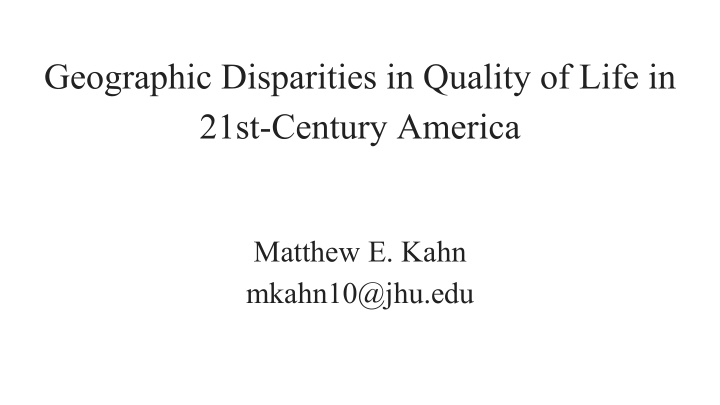



Geographic Disparities in Quality of Life in 21st-Century America Matthew E. Kahn mkahn10@jhu.edu
Introduction ● Non-market local public goods (mild climate, schools, clean air, clean water, safe streets) are inputs in producing safety and comfort and human capital ● At a point in time, Quality of life (QOL) varies across cities and neighborhoods. ● An adult’s locational choice determines her QOL consumption and her kids’ QOL consumption. ● Early life QOL is a key investment input in a child’s future
Ranking Urban Quality of Life by Location ● The logic of compensating differentials teaches us that real estate rents are higher in nicer cities (think San Francisco versus Baltimore) ● Rents are higher in better neighborhoods within a city. ● Urban economists use spatial variation in wages and rents to infer how much people are willing to pay for non-market amenities such as clean air and street safety. ● We estimate implicit hedonic prices
The Key Intuition about Urban QOL Rankings ● A geographic location has great QOL if people remain in a place featuring low wages, high taxes and high rents ● Place based Real estate pricing (think of Zillow) is easy ● Place based earnings data (unlike Raj Chetty other urban scholars work with self reported Census data) ● The fundamental challenge of imputing one’s earnings in a place you have never lived ● The self selection and heterogeneity challenge
Hedonic Prices are Determined by Demand and Supply of Urban Quality of Life ● On the demand side; ● Safety and comfort are normal goods ● We demand more when they are cheaper and when we are richer ● Costa DL, Kahn ME. Changes in the Value of Life, 1940–1980. Journal of Risk and Uncertainty. 2004 Sep 1;29(2):159-80.
The Supply of Urban Quality of Life ● No intelligent design! ● In the field of industrial Organization, economists study what attributes are bundled into a product such as a new Mercedes. ● A for profit firm makes this decision and faces a cost/benefit tradeoff ● In contrast, the attributes of San Francisco or West Baltimore emerge as a byproduct of many independent decisions. ● Facing this reality, a reduced form approach. ● An area’s poverty rate as a sufficient statistic for local QOL such that corr(Poverty Rate, QOL < 0. ● A selection effect or a treatment effect?
The Economic Incidence of Quality of Life Dynamics ● Over time, a place such as New York City or West Virginia changes due to shifts in local public goods ● Falling Crime, Successful environmental regulation, transit innovations ● Incumbent homeowners bear the incidence ● Especially if difficult to build new housing ● The early QOL literature assumed $0 migration costs ● People plant roots over the lifecycle such that migration costs rise with age ● Locational choice is thus a place based bet that you can’t diversify the risk
Residential QOL Sorting Within a City ● A Fact: Minorities and lower income people live in the low QOL cities and areas within such cities ● Explain using an Income Effects theory of neighborhood selection or ● Steered there due to lingering discrimination? ● Implications for their children DiPasquale D, Kahn ME. Measuring neighborhood investments: An examination of community choice. Real Estate Economics. 1999 Sep;27(3):389-424. ● The Chetty Opportunity Insights agenda; what explains the within city variation in later life upward mobility with respect to income? ● The Chetty work does not have an explicit model of neighborhood selection
Supply Side Policies that Increase Quality of Life Inequality ● Local land use regulation --- more pervasive in progressive cities ● Such regulation ⇒ higher home prices ⇒ exclude the poor ● Public housing ⇒ greater exposure to poor people by the poor ● The tension in urban economics and the “Rauch/Moretti” effect ● Person i in location j ● Wage_ij = b1*Skills_ij + b2*City Skills_j , b2>0 social returns to living in a skilled area implicitly means that negative returns to living in a low skill area. ● Where does society want the poor to live?
Conclusion ● QOL literature started by Nordhaus and Tobin Nordhaus WD, Tobin J. Is growth obsolete?. InThe measurement of economic and social performance 1973 Jan 1 (pp. 509-564). Nber. Jones CI, Klenow PJ. Beyond GDP? Welfare across countries and time. American Economic Review. 2016 Sep;106(9):2426-57. ● Revealed preference research not possible for macro research -- no market for passports. ● Urban economists use revealed preference methods ● The poor live in places with low QOL ● Is this fact due to Selection effects or treatment effects? ● Local public goods as inputs in the Heckman dynamic complementarity model of producing a functioning adult
Recommend
More recommend